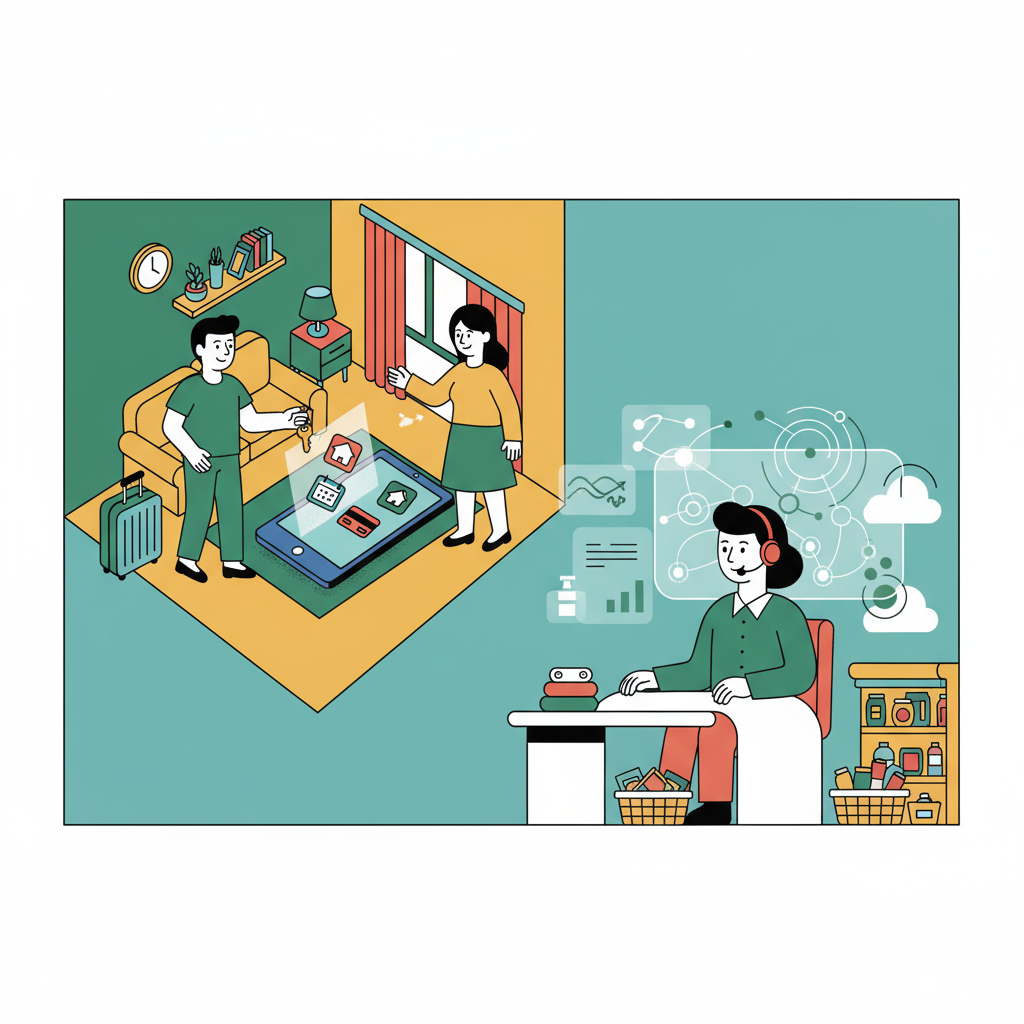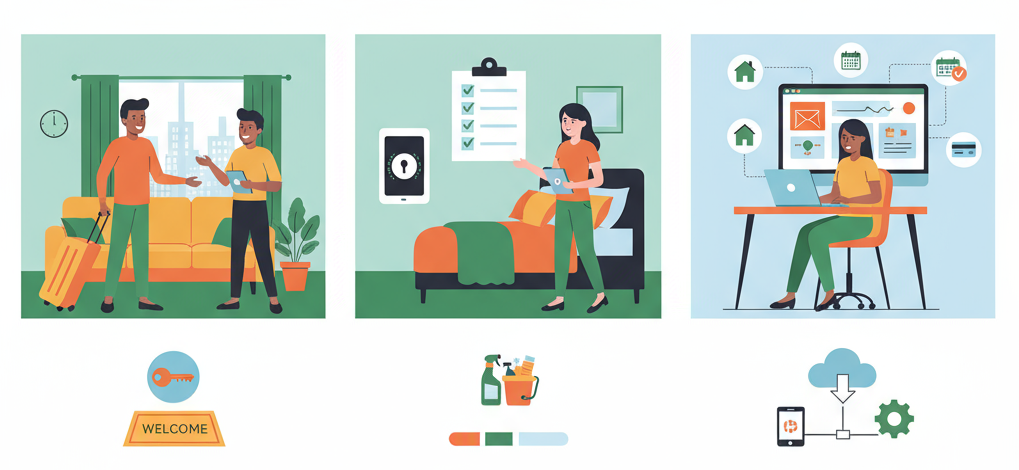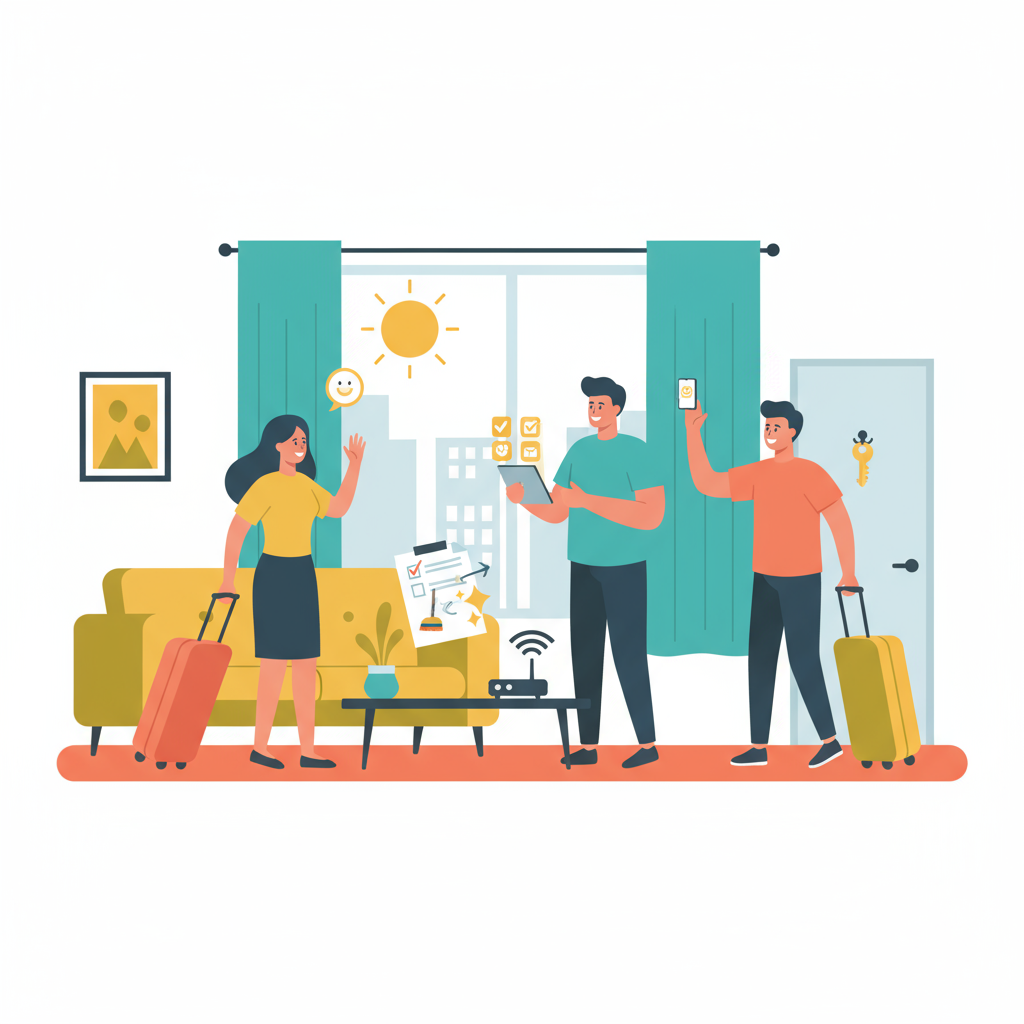Key Takeaways
Self catering accommodation gives guests full control over meals and daily routines, offering flexibility and privacy over traditional hotels.
Operators who offer self catering properties attract longer stays, families, and business travelers who value autonomy and cost savings.
For portfolio growth, self catering listings unlock new revenue opportunities and simplify operations with less reliance on on-site staff.
If you’ve ever booked a holiday home stocked with cookware, a fridge ready for groceries, and the freedom to eat on your own schedule, then you’ve already experienced self-catering accommodation. It’s one of the most flexible and popular ways to travel, giving guests control over their stay while offering hosts a highly marketable property type.
Despite its growing popularity, “self-catering” is still a term that confuses many first-time hosts and international travellers. Does it mean no service at all? Is it the same as a vacation rental? And what exactly should guests expect when they see the term in a listing?
In this guide, we’ll break down what self-catering accommodation really means, how it differs from hotels and serviced stays, and why it’s become a go-to choice for modern travellers. You’ll also learn how hosts can describe and market self-catering properties to drive longer bookings, helping the right guests find the right stay.
What Does “Self-Catering Accommodation” Mean?
Self catering accommodation describes a property where guests take charge of their own meals and daily routines, rather than relying on hotel services or on-site staff.
These properties include vacation rentals, holiday homes, cottages, and apartments that provide a kitchen or kitchenette stocked with essentials. Unlike hotels or bed and breakfasts, self catering accommodation does not include daily housekeeping, breakfast, or concierge services, giving guests the privacy and autonomy to shop for groceries, cook, and live on their own schedule.
For hosts managing multiple listings, self catering means less manual coordination and more scalable processes compared to serviced apartments or boutique hotels. This approach suits families, groups, and business travelers who value independence and cost control over traditional hospitality perks.
You’re in great company
Sign up
Some of the largest short-term rental operators (with 250+ properties) rely on Uplisting's software to scale their businesses.
How Self-Catering Accommodation Works
Self-catering accommodation gives guests the freedom to live like locals, cooking their own meals, setting their own schedule, and enjoying a stay that feels more like home.
Guests who choose self-catering expect more than just a place to sleep. They look for a kitchen or kitchenette with dependable appliances, quality cookware, and enough dining space for the whole group. Practical storage for groceries and longer stays also matters. Adding small touches (like tea, coffee, and a few condiments) shows care and helps guests settle in right away.
The self-catering model fits almost any property type, from city apartments and country cottages to beach villas and mountain chalets. What matters most is independence and comfort: a space that lets guests make the stay their own.
For hosts, success comes down to clarity and consistency. List every amenity accurately, show detailed kitchen photos, and answer common questions before guests arrive. Keep cupboards stocked with essentials, check equipment after every stay, and maintain a spotless space. A well-prepared kitchen and transparent communication turn first-time guests into repeat visitors, especially for hosts juggling multiple listings.
Benefits of Self-Catering Accommodation
Self-catering accommodation brings meaningful advantages for both guests and hosts. It combines independence, comfort, and affordability for travellers while giving operators a scalable, efficient model that appeals to a wide audience.
Flexibility and Independence for Guests
Guests love self-catering stays because they can run on their own schedule. This benefit is especially important for remote workers during their workday, families with hungry teenagers in tow, or even people on a budget, looking to save money while traveling by limiting their restaurant spend.
Ultimately, the flexibility of self-catered accommodation makes every stay feel more personal and less structured, turning even short trips into experiences that feel like home.
Comfort and Space for Families and Groups
Families, couples, and groups benefit from having room to spread out and unwind.
A proper kitchen, dining area, and private living space make it easier to keep routines intact, whether that’s cooking favourite meals, sharing breakfast together, or taking a quiet afternoon break.
The result is a stay that feels both practical and comfortable, no matter how long it lasts.
Affordability for Longer Stays
Being able to cook instead of eating out daily makes travel more affordable. Guests can shop locally, prepare meals on their own terms, and enjoy longer trips without stretching their budget.
This makes self-catering properties especially appealing for extended stays, relocations, or remote workers spending weeks at a time in one location.
Broader Appeal for Hosts
For hosts, self-catering setups naturally attract a wider mix of travellers, from digital nomads needing a workspace and full kitchen to families prioritising privacy. Because guests stay longer, hosts see fewer turnovers and reduced operational stress. Fewer check-ins also mean more consistent scheduling for cleaning teams.
Stronger Reviews and Easier Scaling
When guests feel comfortable and in control, reviews improve. Clear communication, reliable amenities, and smooth check-ins build trust and repeat bookings. For operators managing multiple listings, this model reduces the need for daily service and micromanagement.
That frees up time to focus on scaling, improving efficiency, and maintaining a consistent guest experience across every property.

All-in-one Vacation Rental Software and Channel Management System
Get started in seconds by connecting Airbnb
Manage short-term rentals & bookings, message guests, take payment, and so much more. All in one easy-to-use platform (that never double-books).
Common Misconceptions About Self-Catering
Self-catering accommodation often gets misunderstood, especially by first-time guests or new hosts. Independence is at the core, but it doesn’t mean a complete lack of support or service. The best self-catering stays strike a balance between freedom and thoughtful hospitality.
It’s not a “No Service Zone”
Some imagine self-catering as a hands-off experience where guests fend entirely for themselves.
In reality, it’s about giving guests control while still offering quiet, reliable support. Even when travellers handle their own meals and routines, they expect more than a key under the mat; they want reassurance that help is nearby if needed.
Hospitality still counts
Guests booking self-catering properties value privacy, but they also appreciate clear communication and quick responses. Directions, appliance guides, and troubleshooting information make a big difference. A simple welcome basket, including Wi-Fi details, check-out reminders, and local recommendations, helps guests feel cared for without overwhelming them.
Proactive messaging is key. A quick note before arrival, a follow-up after check-in, or a polite message midway through the stay shows attentiveness while respecting boundaries.
Basic essentials still matter
Self-catering doesn’t mean bare cupboards. Guests expect a few everyday basics to start their stay comfortably. Stock items like salt, pepper, cooking oil, and a handful of condiments. Add practical extras such as sharp knives, tea towels, washing-up liquid, and sponges. These small touches save guests a grocery run and show that you’ve thought about their needs.
The balance between autonomy and support
The best self-catering operations run quietly in the background. Guests enjoy full independence but know that help is one message away. This approach keeps communication light, satisfaction high, and bookings steady, proving that flexibility and hospitality can go hand in hand.
Marketing Self-Catering Accommodation Effectively
Standing out in the short-term rental crowd means getting specific about what guests actually want.
Travelers don’t just want a place to sleep, they want a place where they can cook, relax, and feel at home. A great listing proves it all.
Highlighting key amenities in your listing
Guests scan listings for quick reassurance about comfort and convenience. Use direct keywords like “fully equipped kitchen,” “family-friendly,” and “ideal for long stays” right in your headline and description.
Show clear photos of real kitchens, dining areas, stocked cupboards, and all the details that matter, no hiding the toaster or cropping out the microwave. Honest images build trust and get more bookings.
Setting clear guest expectations
No guest wants to play guessing games during a stay. Outline exactly what’s included with each booking, from cookware and pantry basics to high chairs or blackout curtains.
If guests need to bring their own supplies or towels, say it up front. Point out the nearest supermarket, 24-hour convenience store, or food delivery options. Clear information keeps everyone on the same page and prevents last-minute confusion.
Using PMS tools for consistency
Managing several listings across multiple platforms quickly becomes overwhelming without the right systems.
Property management software (PMS) helps you keep amenities, photos, and booking details accurate everywhere. A single dashboard lets you sync calendars, update descriptions, and track amenities without logging into each site separately.
Consistency across all platforms prevents double bookings and outdated information, showing guests and stakeholders you run a tight ship at any scale.
Create 5-star guest experiences
Give your guests unforgettable experiences
With Uplisting, you can send the right messages at the right time on all booking sites. Read and respond to guest messages in a single, unified inbox — whether you’re at the office or on the go.
Simplifying Self-Catering Management with Uplisting
Self-catering accommodation gives guests the freedom to manage their own routines, meals, and time, making it a top choice for families, long-stay travelers, and digital nomads.
For hosts and property managers, this model offers operational efficiency, lower overhead, and stronger appeal to today’s independent traveler. When managed well, self-catering properties deliver long-term value through higher occupancy, longer stays, and better guest satisfaction.
However, success in self-catering hinges on clear communication, reliable amenities, and consistent experiences across every property. With the right tools, property managers can scale without sacrificing quality. From marketing to guest messaging to calendar syncs, a centralized system keeps everything aligned and operating smoothly.
The key to running short term self-catered accommodation effectively? Uplisting. Sign up today and start automating your Airbnb from day one.
FAQs About Self-Catering Accommodation
What is the difference between self-catering and serviced accommodation?
Self catering accommodation puts guests in control. Kitchens are ready for real cooking, privacy is guaranteed, and daily housekeeping stays out of the picture.
Serviced accommodation, on the other hand, brings in regular cleaning, breakfasts, and sometimes even a front desk. Guests who want to run their own show lean toward self catering; those who want hands-on help pick serviced options.
Do hosts need to provide food or supplies in self-catering properties?
Hosts don’t need to fill the fridge, but small comforts go a long way. A few basics like tea, coffee, condiments, and kitchen staples make guests feel welcome.
Most travelers expect to shop for groceries, but a starter kit (including dish soap, a handful of cleaning supplies, maybe a snack) shows attention to detail.
Is self-catering accommodation suitable for short stays?
Short stays work just as well as longer visits in self catering properties. Guests who want a quick city break, a weekend with friends, or a quiet business trip often look for a spot where cooking breakfast or brewing coffee at midnight feels easy.
Why do guests prefer self-catering over hotels?
Guests are drawn to self catering accommodation for straightforward reasons: more space, privacy, and complete control over routines.
Families can spread out, remote workers get space to focus, and everyone skips the hotel rules. Cooking meals, relaxing in a real living room, and setting a personal pace often make a stay feel like home, even if it’s just for a few nights.
















.png)

